

![]()
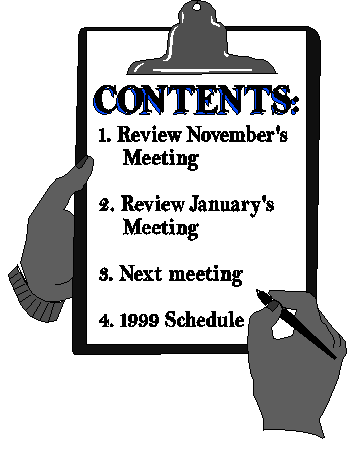
I hope everyone had a good Holiday Season. It seems like a long time since I prepared a newsletter. I guess thatís because it has been a long time. I had a nice break during the Christmas season and now I'm finding it quite a struggle to get back into the habit of putting a newsletter together. Plus, this newsletter is larger than normal. Two "reviews" are included this month.
You may think itís odd to have a summary of Novemberís meeting when itís now almost February (Wow, I did have a nice break didnít I?). But, since I didnít do a December or January newsletter I havenít shared the information from November's meeting yet. It was a very informative talk on an area of concern that most parents who have children with autism face. Therefore, I believe it is worth sharing now. You will also find a review of the January 1999 meeting
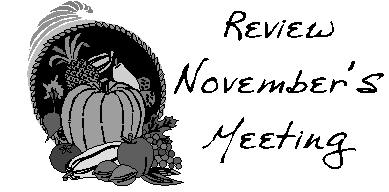
Barbara Hurtgen, Regional Autism Consultant in Florence, addressed
Communication Issues during our November 1998 support group meeting. First Ms. Hurtgen presented an overview of communication issues related to autism and then she offered suggestions on how to communicate with children having autism.COMMUNICATION OVERVIEW:
There are many issues related to communication in autistic people:
Language development is usually delayed or non-existent (30% - 50% are mute). Many times it is this delay in language development that prompts parents to have their toddler evaluated by a specialist.
Receptive and expressive language is often impaired. Thatís why many autistic children donít seem to follow directions well. They may not understand what is being said. (See illustration below)
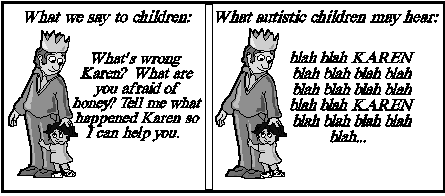
Comprehension of verbal and gestured communication is limited.
And the expression of non-verbal communication is impaired. Speech is one part of early language development. It also consists of non-verbal message sending and message receiving cues. The non-verbal part of communication (eye contact, pointing gestures, turn taking, initiating a topic for conversation, maintaining and/or elaborating on the conversation, etc.) is referred to as the language pragmatics of language development. Certain social skills as well as linguistic skills are required to develop this non-verbal form of communication. Unfortunately, that is at the core of what autistic people have the most difficulty with. For autistic children, language pragmatic skills need to be specifically taught.Some higher functioning children may have lots of language but are very concrete, literal thinkers. Which means they usually have a difficult time interpreting slang, sarcastic comments and jokes.
Auditory processing problems can also interfere with communication. You may notice behaviors such as inconsistent responding (may be voluntary or involuntary), hypersensitive to noise and environmental stimulation, or obliviousness to noise and environmental stimulation.
Echolalia, speech that consists of echoing back what the child has just heard, is prevalent in autistic children. Immediate echolalia is an instant response that ranges from a rigid, word-for-word, mimicking (including voice inflections), to a milder repeating that actually has some change. Delayed echolalia occurs when language that was heard sometime in the past is repeated later. This form of echolalia may be communicative (considered appropriate response) or non-communicative (not an appropriate response).
Voice quality and prosodic features are described as poor pitch modulation, inappropriate volume of voice such as loudness or "whispered speech", and monotonous tempo or inconsistent tempo.
Self-stimulatory vocalization could also be described as a monotonous tempo including puppet-like, wooden, staccato, lacking affect, or mechanical. Another form of self-stimulatory vocalization is the repeating of television or radio scenes. This is sometimes referred to as "TV talk".
Verbal children may need help with communication skills (this can overlap with social impairment). Some areas of concern are expressive verbosity, questioning, preoccupation with verbal exchange rather than content of conversation, insensitive to nonverbal cues of boredom, unaware of the need for back ground information, and lack of role taking because of a poor perception of a the listenerís needs (part of the language pragmatics problem), etc.
Other issues related to communication in autism are pronoun reversal, patterns of communicative behavior may be highly idiosyncratic, literal interpretation of speech, and difficulty in understanding concepts or long sentences.
Ms. Hurtgen continued the workshop with examples of how to communicate with autistic children.
SUGGESTED COMMUNICATION APPROACHES:
1). Be as positive as possible:
- If itís not important, ignore it.
- Avoid using "no".
- Donít expect them to perform at an adult level.
- Tell them exactly what you think they are doing well at. ("I like that picture you drew" or "good drawing", "good writing your name", "good cleaning up", "good answering", etc.)
2). Teach students to listen.
- Incorporate the "Your turn/My turn" routine during many daily activities.
- Get the childís attention before you begin speaking. Get down to childís level, ask for eye contact, "look at me", etc.
- Give them a little wait time before intervening. Leave 3 to 5 seconds between giving the instruction and then prompting them to perform.
- Praise all attempts to perform
3). Know what you want the child to do.
- Have a plan ahead of time.
- Be clear
- Be sure
4). Give adequate information.
- Use visual cues to help your child understand.
- Visual schedules can smooth transitions.
- Explain ahead of time to prepare them for whatís coming.
5). Use language that is simple, clear and as concise as possible.
- Donít be to "wordy" (see illustration on previous page).
- Sequence your directions with "first" we will, "then" we will...
- Use appropriate tone of voice. Firm voice equals direction or correction. Happy/Excited voice equals praise.
6). Tell them what to do and avoid telling them what not to do, when ever practical.
- Instead of saying "get down" say "put your feet on the floor now".
- Be specific "sit on the chair now".
7). Be as neutral as possible when giving directions.
8). Avoid asking a question with a choice unless the student really has a choice.
- Donít say "Do you want to clean up toys?" or "Itís time to clean up ok?" Instead you could say "Now itís time to clean up".
- Only use "letís" and "we" if you are going to do it also.
9). Teach children to respond immediately to learned words, phrases, gestures, environmental cues or questions. ("Stop", "come here", etc.)
- Remember to praise them for obeying ("good coming")
10). Label feelings (sad, happy, etc.).
- Explain to your child what feeling he may be experiencing ("you seem happy",
"The dog frightened you", "youíre angry because itís time to stop playing", etc.)
- Explain to your child what feeling you, the parent, may be experiencing.
- Use pictures from books or magazines to show other people expressing feelings. Explain what feeling they are expressing. See if your child can guess the feeling.
11). Avoid labeling people verses labeling the action.
- Itís not always appropriate to say a person is bad or good, but what they did may be called bad or good. ("Good coloring." "Good sitting quietly." Etc).
12). Avoid reprimands
- Because they donít really care (thatís part of the disorder). Sending them to their room alone may be what they want.
- Prevent outbursts by avoiding known, explosive situations.
- Set consistent rules and routines.
13). Avoid threats.
- Use positive consequences (when/then- "when you sit, then you get") instead of negative consequences (if/then- "If you donít, then you donít).
14). Elicit Communication by setting up a situation where they have to give a verbal response.
- Give choices ("Do you want orange juice or apple juice", "blue truck or green truck", etc.)
- Set up a need for help. Donít automatically refill their cup. Try waiting for them to attempt asking.
- Keep their favorite toy in site, but out of reach so they will have to seek your help. Then prompt them to use a word to describe what they want ("Do you want the toy or the book?").
- View any attempt to express the word as success, even if it doesnít sound like the correct word.
- Remember to praise for all attempts at talking ("good talking/asking")
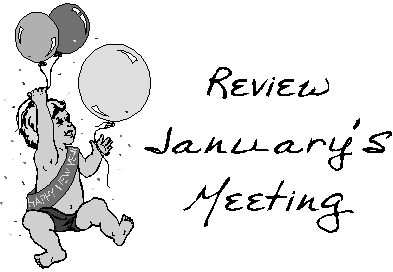
We did not hold a meeting during the month of December. Our last meeting was January 7, 1999. Jerry Evans, Teacher Consultant with the Autism Division of Florence, explored the topic of
Schedules and Routines.What is a routine?
A routine is regular activities needed to function in an environment. Routines should include positive activities that fosters growth and development, which is vital for developing independence. Most of us understand how important a daily routine is to our children. We also understand the necessity of introducing change to their routine. Itís ok to have a comfortable, predictable day as long as we avoid becoming absolute and rigid. Thatís difficult since most people with autism lean toward being rigid and absolute.Introducing change to a routine could probably be met with resistance. A tool to assist our children and us in following a routine and introducing change is a visual schedule.
What is a visual schedule? A visual schedule is simply a visual representation of a daily routine, or a visual "to do" list. These schedules can range from concrete (using actual objects) to abstract (using pictures, photographs, or words) and can be as simple or as sophisticated as you see fit.
Why use a visual schedule?
Communication and engagement:
It is a positive way to help communicate what is expected to a child who doesnít understand language well. If your child responds well to photographs, he may enjoy seeing his daily routine described to him through pictures (photo of clothes for time to get dressed, photo of place setting for time to eat, etc.).
- You can use the photos (or objects) to engage them in conversation by asking questions like "Whatís next?" and giving them the opportunity to respond with words or gestures.
- Keep your children productive by involving them in removing a completed task from the schedule. Attach a "finished" envelope or "finished" box to the bottom of the schedule. The removed picture is then placed in the "finished" envelope.
- It is a positive way to learn. Children can learn skills such as sequencing, following directions, reading, doing chores, etc.
- Can assist with reaching future independence goals. Eventually children could be taught to monitor their own schedule. Parents and teachers should encourage this by saying "check your schedule to see whatís next".
Basic concepts to consider:
- Itís important to consider the level of your child when choosing a schedule type. They can vary from concrete to abstract. A concrete schedule may use actual items (a spoon for time to eat, crayon for coloring time, toilet paper for bathroom time, etc). A more abstract schedule may use photographs or magazine pictures. If your child can read you could go even further into the abstract by using just words (the goal is to move all children up to the point of just using words on their schedule).
- Labeling the items that go on the visual schedule will help achieve one main objective, to eventually move your child from the "concrete" to the "abstract" schedule. If an actual spoon is used you should still label it with the word "spoon" or "supper time". If photographs or drawings are being used, label them with the actual word they represent (a photo of a place setting may be labeled "eat" or "supper"). This can foster cognitive learning and encourage reading. Also, remember to be consistent with all members of your childís therapy team and family members when it comes to what you call certain items. If you prefer bathroom instead of potty, make sure all people are using the term bathroom, otherwise confusion may occur.
- Encouraged interaction by having the child take items off the schedule when the task is complete, or encouraging your child to check his schedule and tell you what is next.
- When preparing the schedule use the pre-macking concept of rotating fun activities with "not so fun" activities. Usually begin with something-easy then build up to a more difficult activity. Always follow a difficult activity with a fun/easy activity so the child will see there is something to look forward to.
- The easy activities can be a form of motivation for your child. Another motivation is to schedule breaks, treats, or "childís choice". These breaks work well around areas of the schedule that in-tails activity you know are difficult for your child. For example, homework must be scheduled, so maybe a snack can appear on the schedule before homework and then a favorite book or video will follow homework on the schedule.
- A mini-schedule is useful when you want to become more specific about an item from the "master schedule" (the main visual schedule). If you are trying to teach your child how to behave at the supper table, you can pull out a mini-schedule that will break down the behavior you desire into steps. The mini-schedule can be a small photo album with pictures of your child sitting still at the table, staying in their chair, using spoon or fork, etc. You can also use a mini-schedule to ease transition to change. If you have to make an unplanned trip to the grocery store for example, you can use a mini-schedule to show a photo of the store, of your child "walking calmly" in the store, using "quiet voices" in the store, etc. It is probably a good idea to plan an easy/fun activity before and after the trip to the store (pre-macking).
Photography (Experience is not required. Jerry offered some tips on choosing equipment.)
- Camera should be considered an essential piece of equipment for the home, but it does not have to be expensive. There are many fine inexpensive cameras available.
- 35-mm camera is his choice.
- 200 ASA film speed should meet most of your needs. Store brand film is the most inexpensive and should be fine for this type of project.
- He found Samís Club and K-mart to offer reasonable prices for film development. Get the cheapest processing using the smallest size print.
- When shooting the photos, try for close-ups containing few items. Avoid busy pictures, especially if your child canít tolerate it. (Example; if you need a picture of McDonalds, just get the sign instead of the entire parking lot and building. Or just shoot a place setting to represent "meal time" instead of trying to get the entire room with table and chairs, etc.).
- You donít need to worry about taking award winning photographs, as long as they are in focus and the child understands the concept (again, labeling will help as well).
- Find an index card box or other storage box to store the large collection of photos or magazine clippings you will probably accumulate.
Basic materials needed:
- 35 mm camera and film
- Magazines to cut out pictures
- Velcro and/or magnetic strips
- Sticky labels
- Felt pen or magic marker
- Pocket photo albums (dollar store)
- Glue stick
- Construction paper or poster board
- A box to store photos or objects when they are not being used on the schedule.
Making the visual schedule:
- First consider what tasks you want to include on a schedule. Make a list of these tasks and then proceed to gather objects, photographs, or magazine clippings. If your child can read you may be able to skip gathering photos and write the schedule out instead.
- The schedule base can be made out of poster board. Cut the poster board into the size you need.
- Select the objects, clippings, or photos you will use (assuming youíve already completed the step of shooting and developing the pictures). You could also be creative by adding items like clocks, favorite shapes, colorful backgrounds for special/fun activities, or make the base of your schedule a fun shape such as a schoolhouse, etc.
- Use the magic markers to write the name of the activity onto the labels. Use a minimal amount of words. Attach the label to the item representing that task.
- Attach Velcro or magnetic strips to the back of the item. And then the item can be attached to the schedule base. Magnetic strips can actually attach directly to your refrigerator or other metal surface.
- Select an envelope, box or other item to be used as the "finished" box. You can attach this box with the same method you used for the above items.
Using the visual schedule:
- Teaching: Remember that your child may have to be taught the routine of using a visual schedule. This may initially include going to the schedule with your child to show them how it works, prompting and verbal cues, and lots of praise when your child shows any effort to use the schedule. Eventually you can fade prompting to pointing (some may need hand-over-hand assistance with pointing), then fade to independent pointing, and then fade to another independent level.
- Time Management: Try not to overwhelm yourself. Use it for the time when you can do it. You may only be able to start with an hour of scheduled activity. Some may be ready to use a schedule from the time your child arrives home from school to assist in structuring homework, chores, playtime, etc. Another solution to time constraints could be the mini-schedule. Make up a few mini-schedules to cover certain times of the day.
Elaborating on a basic schedule:
- There are more exciting benefits to be gained from a visual schedule. When you are able to move into a more abstract type of schedule your child will begin to learn symbolically. Which is good because there are many items in our society depicted by using symbols. Common symbols could be incorporated into the schedule, such as the restroom symbol, or the knife and fork symbol, etc.
- More communication opportunities will be possible. There are many ways to teach language and memory skills through the use of a visual schedule. You can try to engage them in spontaneous language and social exchanges while incorporating skills such as telling time, previewing, reviewing, etc. This can be accomplished by asking questions such as "whatís next?, "what time is it?" "Tell me what you are doing today?", "Tell me what you did today?", etc. The schedule can serve as a tool to help the child remember what he did as well as help give him the words he needs to verbalize his thoughts.
Overall, this really seems like a powerful tool that could assist you and your child in many ways. For additional ideas check these resources:
Resources:
- Visual Strategies for Improving Communication by Linda Hodgdon, QuirkRoberts, Publishing (810) 879-2598.
- Autism Society of N.C. (919) 743-0204.
- Boardmaker software (Is very expensive so try the school district for access to this material).
Sample Visual Schedule:
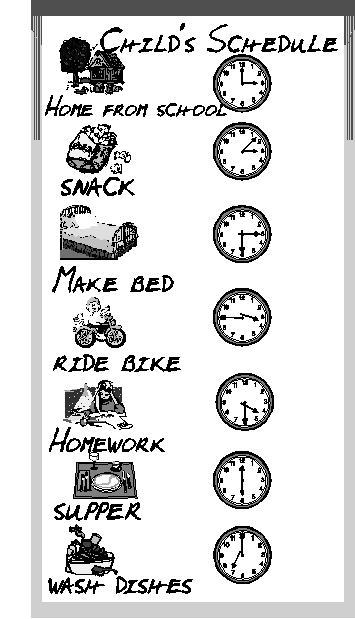
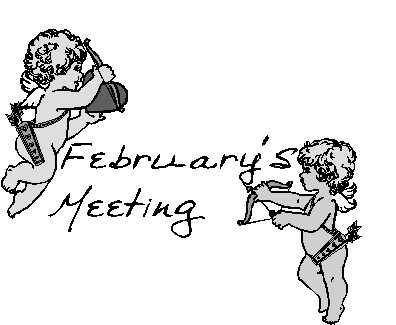
Thursday, February 4th, 1999
6:30pm to 8:00pm
WHERE:
Staff Development building
The Pee Dee Center in Florence, off of National Cemetery Road.
(See attached sheet for directions)
* Respit/child care Services:
You must call the Florence Autism Division office at (843) 664-2720 to register your child. Respit services will not be available at this meeting if there are no children registered by February 3rd, so please call as soon as possible.WORKSHOP THEME:
6:30pm - 7:15pm - Teaching Techniques at Home:
7:15pm - 8:00pm - Affects of Policy Changes:
Don Fender, State Director for the Autism Division with DDSN will attend our meeting. He will be available to discuss changes that will affect the South Carolina Autism Division.
Following are some questions parents may want to consider:
1). a). What is the latest information on secretin?
b). Will the Autism Division do a pilot study on secretin?
2). a). Why are school contracts being discontinued?
b). How will Regional Consultantís maintain consultations and relationships with parents and teachers at the same frequency?
3). What are family support funds and how do we apply for them?
4). Why donít Regional Consultantís develop an ABA Home program and provide therapy, program development, consultation and training?
5). DDSN Boards & Respit:
a). Why are hours limited at the DDSN Boards?
b). Why are they different at each board?
c). Do PCAís (Personal Care Aids) have to be qualified through the Board or can any one provide respit care?
6). How can we get more adult services? (I.e. autism division job services)
7). Will there be independent or semi independent living options for people with autism in our region? (How long is the waiting list?)
8). What summer services will be available?
Please feel free to add other questions or concerns to the above list. Mr. Fender will try to answer what he can.
AUTISM
Parent Support Group Newsletter Florence, SC 29501 email: [email protected]